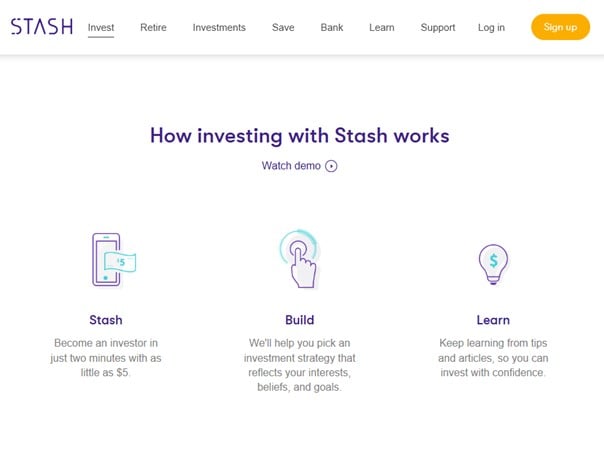
3 Trends in Domestic Appliances & Household Care
Written by Anita Janssen
Take a closer look at 3 trends in domestic appliances & Household care from our What Matters 2023 Report. Read more here.
Remember that last app you thought would finally teach you how to invest your money and check off that box in your adulting to-do list? Stash was created for people that don’t have a lot of financial experience but desperately want it, and they want it now. Since 2016, an estimated 2/3 of Americans couldn’t pass a basic financial-literacy test, meaning they got fewer than four answers correct on a five-question quiz. 80% of U.S. adults agree they could benefit from advice and answers to everyday financial questions from a professional. When it comes to managing money, only 17% of Millennials declares feeling prepared. And out of all potential target audiences, the next generations don’t just feel unprepared, they’re also extremely vocal about it.
Stash has chosen to target the next generations that want to explore the idea of investing their money but don’t want to risk losing it all. The next generations may not be financial gurus right now, but they are eager to learn the ropes, especially when it comes to investing. The problem is that many of them have been scarred by the Great Recession, and now they’re afraid to lose their precious, heard-earned cash. 49% of next-generation youngsters says that the 2008 financial crisis changed the way they think about saving/ investing/ spending.
The next-generation (aka anyone born after 1980) audiences grew up in times of technological (r)evolution, but they are also financially inexperienced and afraid of risk, which makes them a fickly fintech target. So why has Stash been able to capture nearly 1.5 million customers and raise $80 million total capital in only two years? In frAGILE (a next-generation marketing bookzine), Joeri Van den Bergh and Katia Pallini conclude that as a result, the next generations interact differently with brands than their parents and grandparents. Stash hits the nail on the head of a few key trends we uncovered, and as a result has provided examples of opportunities where fintech as a whole can learn and build.

Fintech must simplify their financial processes, previously seen by many as black boxes, into a few simple steps.
Why is this accessibility important? Because the next generations don’t respond well to brands that play hard to get. In terms of user experience, they expect things now, as fast and as easy as possible. So brands need to provide top-notch user experiences, reducing the time and efforts on the customer’s side. By making onboarding as simple as possible, Stash reduces the number of clicks to a minimum so that people will come back for more.

Fintech must adapt in order to cater to these seemingly scatterbrained passion points. Stash allows users to invest their money in as many contrasting causes as their hearts desire, by allowing them to choose from over 30 ETFs (Exchange-Traded Funds defined on the Stash website as investment baskets bundled into a fund that is traded on an exchange). These investment bundles are separated into three categories: “I believe”, “I want” and “I like”, allowing users to invest their money in as many contrasting causes as their hearts desire.

They are unpredictable switchers that use their own value system for choosing products and brands. Fintech can do this by connecting users to causes they care about. Stash tapped into this insight by including ETF options such as “Do the Right Thing”, showcasing socially responsible businesses with a positive impact on the environment, social, and governance issues; “Water the World” supporting global water companies; and “Small but Mighty”, standing up for small, capitalized companies that have room to grow.
By taking the focus off of brands, fintech can put it back on the individual and on what they want to accomplish. In Stash, the actual brands included in each ETF aren’t obvious on the interface. You only see them once you choose a specific category.
Investing has traditionally always been seen as a competitive enterprise, available to those that have lots of cash. But in order to engage with the next generations, fintech must do away with this individualistic approach to finance and embrace a culture of collaboration. Brandon Krieg and Ed Robinson, Stash co-founders, have not only made investing simple, as explained previously, but they have gone to great lengths to provide ample information to Stash users, through an in-app “Learn” page featuring articles that answer questions as basic as “What is a hedge fund?” and “What’s the CFPB?” Stash also created its own podcast, ‘Teach me How to Money’. By democratizing investment information, Krieg and Robinson created a top-down sharing culture.
Stash investors have created a collaborative Facebook group dedicated to providing each other with investment advice and sharing their own experience with each of the different ETFs. What’s going on here? Users are mimicking brand culture behavior, and this is the ultimate indicator of brand identity fit, especially in a category where sharing information is not commonly adopted behavior.
Fintech has an opportunity here, and it starts with listening to the next generations’ voices. Stash did this, and according to Business Insider it is now valued at $240 million. That’s a lot of money… but the look on your dad’s face after you’ve just brought up the dividend yield on your Blue Chip portfolio at the holiday dinner table, that’s priceless.
Want to explore how your brand can connect with the next generations, and Gen Z in particular? Discover what our research toolbox and expert power can do for your brand!

Written by Anita Janssen
Take a closer look at 3 trends in domestic appliances & Household care from our What Matters 2023 Report. Read more here.

Written by Delphine Vantomme
Take a deeper dive into what trends are coming up in Beauty. A closer look at the industry from our What Matters Trend Report.

Written by Scott Lee
From our 2023 What Matters Trend Report, find a closer look at 4 trends in Finance and what you can expect to see in this industry.